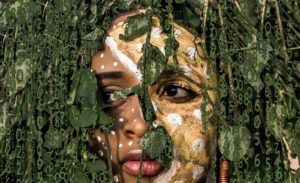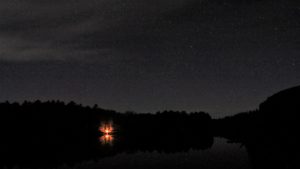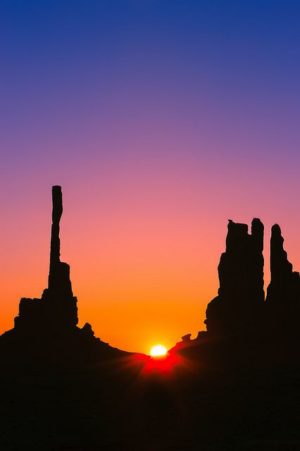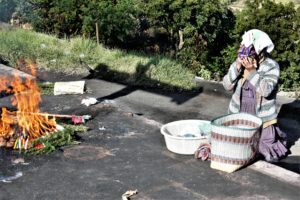
The roots of shamanism reach back into the fog of time, to the very beginning of humanity. Through time and cultures, it is recorded as a coherent system of esoteric beliefs and practices that attempts to organize and explain the interrelationship between the cosmos, nature, and man (Eliade, 1964), and spans untold generations from the first ‘ring of fire’ to our present day. Shamanism is characterized by a subject-object dualism that dissociates, yet, paradoxically, at the same time associates the subjective from the objective, and culture with nature. Shamanism is linguistically and locally specific, with rituals grounded on reliance in communities’ environment for subsistence and survival. Today the shaman’s functions are as critical to the lives of traditional indigenous peoples as they were to their forefathers.
The fundamentals of shamanism rest on the bedrock of the nature-culture dichotomy or human-nature duality. Early in their long march from the depths of time, humans had to compete for survival with the claws, fangs, speed, and power of the rest of the animal world. Their only defense was an unusually powerful brain. This helped them withstand the onslaught of nature. Cooperation was essential for the sake of survival of the group. This was especially true for the protection of mothers and infants, since during the last months of pregnancy and after delivery, females could not easily fend for themselves. Hundreds of thousands of generations ago, the ‘ring of fire’ was the first awakening of hunter-gatherers to a world beyond their awareness. In the dark of night, the fire lit a circle beyond which everything was threatening. This fear of a different world beyond that of the group, paid for dearly through trial and error, lies at the heart of the nature-culture duality, a key aspect of shamanism, and it was fundamental to the organization of early human societies.
_______________________________

The Ring of Fire. ©dacker.org
_______________________________
Mythological perception in ancient cultures was grounded in their perception of the natural world, as their remains from the Lower Paleolithic period seem to testify, as well as long before. Back then, the nature-culture dichotomy was already deeply ingrained in organized groups as key to their survival. This ancient dual perception of the world by most indigenous people is grounded in animism, a common denominator that describes most foundational aspects of ancient cultures and their beliefs. This denominator was inherited by modern humans, who co-habited within the territorial range of Neanderthals during the Late Pleistocene. Of note is the hypothesis that Denisovans and Neanderthals may have already been aware of an “other world” beyond life. Remains in their graves appear to bear witness to rituals of individuals buried with personal items, such as carved animal bone implements and medicinal flowers (Solecki, 1971)
Ancient societies named themselves according to their living and feeding area. Location drove their own binary interpretation of the nature-culture duality. In the rain forest of Panama, for example, the generic name for the Guaymí, an indigenous tribe, comes from the “muoi” dialect and means “man.” The name does not refer to gender but stresses the exclusive prominence of the group to the exclusion of others. These “others” are not considered “man,” owing to their differences in the group’s perception of the cosmos and nature, as expressed through their customs and rites. The “others” also had their own perception of duality and identity, as had other tribes. Furthermore, the gateway to beliefs and initiation is first and foremost language. The reason rests on the conviction, found in most ancient cultures, that malevolent forces can take the shape of a member of the tribe, but cannot speak the language, quintessential to the group’s identity.
The Shaman and the Tree of Life
In traditional communities today, as in most cultures in the prehistoric and historic past, individuals are selected to communicate at the esoteric plane of their mythological universe; these individuals are referred to as shamans. The name, of Siberian origin, came to the Americas with the first wave of migrants from the Eurasian landmass during the Last Glacial Maximum (33000-16500BP). The fundamentals of archaic mythologies with spatial multi-layered organizations probably came into the New World at that time; an observation that underscores the fact that mythologies are pure products of the human imagination. In most cultures, the upper and under worlds are perceived to be made of a number of layers that vary from culture to culture, and are the reflection of a primeval mythology. What is “known” or learned therefore, is more important than what is “seen” or perceived, since only a member of the group who fully shares a mental and emotional make up can understand the significance of the symbols attached to that community’s mythic world. In most traditional cultures past and present, the upper world is regarded as the home of ancestors, light and life, while the underworld is identified with malevolent spirits, darkness, danger, and death.
The link between these worlds is the middle world, or field of ordinary perception; the place where the observer, the community or clan lives, and the center through which the tree of life, or “axis mundi,” passes to connect the three worlds. The “tree of life” is believed to have its branches and leaves reach into the upper world while its roots are sunk deep into the underworld. For each human group, there is only one “tree of life” in the world — theirs! It can be an actual tree or a natural feature in their landscape, such as a mountain or a cave, mythologically identified by and for that group alone. In all world cultures, the “tree of life” is the obvious manifestation of immortality as “life that never dies.” The reason for this perception, at the root of animism, lies in the fact that without exception, the natural world for all cultures is the undeniable proof of the permanence of life through its unrelenting cycles of birth and re-birth. The tree of life for Maya communities’ past and present, for example, is the ceiba tree, or “yaaché” (ceiba pentendra).
The Universe
In most world cultures, their worldview was based on a seven-point observation of the spatial universe and their endless repetition. Those are: the four cardinal points, the zenith (benevolent forces), the nadir (malevolent forces) and the center (middle/living world), which is at the intersection of the first six points, where the observer stood. Of note is the fact that the nadir was believed to be an actual place, or adobe of malevolent deities below the flat world of humankind. This ancient universal world view was based on the observable continuum of the sun, moon and planets, traveling through both the upper and under worlds. The celestial bodies were seen crossing the visible world during the day on an east-to-west path, then believed to continue their course from west-to-east in the underworld at night, to start again a new cycle the following dawn since, how else could they show up again opposite their place of disappearance? After all, sensory perception could not be denied, since the sun indeed disappeared to reappear again day after day.
______________________________

The Eternal Return. The totem pole at sunrise, Monument Valley, AZ. Credit: Floydian
_______________________________________
The repetitive seasonal course of the celestial bodies was observed through manmade or landscape features to ascertain their regularity. Priest-shamans needed to justify, through time, that the sun would never fail to reappear at precisely the exact same place, day after day, solstice after solstice. Hence the need to associate heavenly bodies with the gods and deities of their pantheon as reliable mediators with nature. Once more, the nature-culture dichotomy with gods (culture), assigned mediators to nature (sun, moon), is at the core of age-old beliefs, religions and shamanic rituals.
The nature-culture duality is at the root of an unshakable conviction that a human group spatial location is what stands it apart from others. Furthermore, it affirms the uniqueness of the group’s faith to the exclusion of others. Their multi-layered spiritual world is essential to their understanding that every life-form within the field of ordinary perception has its counterpart in the “other” world. The gateway between the middle world and the two others is the human mind. Through learning, rituals and esoteric exercises, the shaman is believed to master this field of opposites, as he roams through these upper and under worlds.
The Shaman as Mediator
But, who is a shaman, and how do shamans communicate and enter into the various strata of their worlds? According to the shamanic beliefs of indigenous tribes and traditional communities, the echeloned worlds lying beyond the field of ordinary perception correspond to a microcosm (or “micro-worldview”) consisting of a sequence of dimensions of the individual’s own interior world, or inner scale of human consciousness. The shamans claim that their hallucinations, induced by psychotropic drugs, allow them to penetrate into the different stratas of that “other world” as though through narrow openings.
The name shaman comes from the word “sàman” of Manchu-Tungus and Sim-Evenki languages of southwestern Siberia. It is gender neutral and apply to both men and women alike. The initiation rituals, however, are gender specific by reason of the candidates’ physical and emotional particulars. Shamans of both sexes may, however, act in concert for specific situations where they are called to ward off malevolent male and/or female deities and during ceremonies when under stress by multiple hostile forces. In the Americas, it is relatively common for both husband and wife in a couple to be shamans. The role of shaman is performed by intelligent individuals who fulfill a number of important functions in their communities.
They are healers, say prayers, direct puberty rituals and major ceremonies such as at the time of crop planting and harvesting, among others, and for individuals’ life cycles. They are keepers of the genealogies of the tribe, recite myths, do ritual dances and chants during traditional events. They are also very knowledgeable about nature and influence decisions for hunting and conservation of resources. Their functions as mediators in situations of social conflict within the community, or with another group, is very important. However, shamans are first and foremost mediators between this world and the supernatural world (Eliade, 1964).
Contacts between genders within a group are governed by ancestral family and community-tested rules that aim to keep antagonism and latent violence at bay. For example, the nature-culture dichotomy is underscored at the time of menstruation, and perceived in most traditional cultures as a dreaded return to nature. As such, it is perceived as a recurring antagonism to culture, given the uncontrollable periodic nature of the event. At that time, in traditional communities, a woman is confined to a separate hut, that is, she is temporarily excluded from culture. In the case of young males, initiation to adulthood aims at bridging the nature-culture duality to incorporate the individual into the cultural group by forcefully bending nature over to culture. The rituals test the young man through lengthy isolation beyond family and community, and with often painful rituals. In past non-literate societies, pain was inflicted to young individuals as a “marker of time”. In most ancient cultures, initiation for both genders took place at puberty.
_____________________________

Blessings of Daily Needs. ©nathansiemers
_____________________________
The position of shaman may be inherited or revealed in a vision or a dream. Someone may also become a shaman simply by following the vocation, but in this case the shaman is considered less powerful (Eliade, 1954). Apprenticeship, under the guidance of a practicing elder, takes years and extreme hardships that will end with initiation (in the Sierra Nevada de Santa Marta, in Colombia, the Kogis, descendants of the Tairona, require a double cycle of nine years each before initiation). It is practically a universal rule that the neophyte must die symbolically, to be later reborn endowed with certain supernatural powers (Reichell-Dolmatoff, 1991). As a general rule through most cultures, a shaman is not acknowledged unless he has received two essential kinds of teachings: mastering ecstasy (dreams, trances, etc.), and traditional shamanic techniques (that will include learning the names and functions of spirits, the mythology and genealogy of the tribe or community, a secret language, etc, (Eliade,1951).
In past and present traditional societies, ancestor worship is a key constituent in people’s spiritual lives. The shaman, upon request, may assist in communing with ancestors, but the descendants alone shall address their forefathers to intercede in the resolution of family or individual conflict. Ancestors are believed to influence the lives of individuals of the same patrilineage. They are also believed to help settle disputes with ancestors of other patrilineages for grievances that may have taken place a few generations before, unsettled at the time of the demise of the interested parties, the antagonism still lingering beyond the grave (Eliade, 1964). Descendants are keenly aware that they are merely a link in the precious chain of life, from grandparents to grandchildren. Above all, ancestor worship is grounded in an age-old stern but inescapable logic: No ancestor-No descendant-No Life!
In former times, the burial of an ancestor below the floor of the house or in proximity to it, meant that the ancestor was still “socially alive” in the community, thus validating claims of the family connection with that group, while upholding family rights to resources left by departed parents. The building of temple-pyramids and other major structures in ancient cultures of the Americas, for example, were representative of the high status of persons of the realm. They were an acknowledgement of the individual’s lineage and that of a powerful and often deified ancestor, protector of the community and his descendant’s rights to titles and properties. Myths and rituals are integral to the construct of the social order. In the final analysis, the essential function of beliefs and rituals is to forcefully express, and thereby secure, the social stability of the group.
_______________________________

Appeal to Another Reality. Chuch’qahaw (high priest-shaman), Rigoberto Itzep Chanchavac, Momostenango, Totonicapán, Guatemala – July 10, 2013. ©georgefery.com
_______________________________
Altered States and Animal Spirits
The shaman’s main communal function requires his/her association with the supernatural world through an altered state of consciousness. Altered states vary among cultures and are achieved through deep meditation, sensory deprivation, or sudden visions of supernatural beings or situations. In most parts of the Americas, however, ecstasy is more frequently attained by means of psychotropic plants, since nature is regarded as a gift from the gods, providers of food and medicinal plants on which human survival depends.
The use of hallucinogenic drugs is an ancient, worldwide cultural phenomenon. In most traditional cultures, it is closely related to the so called shamanic flight, the feeling of disassociation during which “ch’ulel” as the Maya-K’iché refer to it, is believed to separate from the body and penetrate other dimensions of the cosmos. At that time, shamans acquire their familiar totems, the spirit of animals that will become their auxiliaries. Chief among them in the Americas are the jaguar, the serpent and the eagle, representatives of the three levels of life: the underworld, the middle world of perpetual life, and the world above.
During these “flights,” shamans call on supernatural and ancestral beings about present and future events, learn new spells, chants and dances, or search for cures to ward off diseases. They will also roam the underworld for remedies to cure the souls of sick people and help those dying through the difficult the paths on their way to their last resting place. The idea of other dimensions as dwelling places of the spirits of the dead and fantastic beings is based on the experience of the ecstatic journey of the shaman. Therefore, the image that shamans form of these dimensions and the description they give of them depends on the projective process of their psychological personality and experience as practitioners, as well as on the cultural and religious tradition of the community and its environment.
Among traditional cultures, individuals are endowed at birth with the spirit of an animal companion, called “nawal” in Maya-Yucatec and “tz’iip” in K’ichè communities. It is a co-essence from the animal world. With the assistance of the shaman, a “spirit companion” is ceremonially selected at each major step of an individuals’ life, from birth to death. In other words, the “nawal” is understood to be an essential life force, an “alter ego” that must not to be confused with chu’lel or soul, in K’ichè (Uk Ux ‘Be, 2008). The “nawal” selected by a shaman is believed to follow the person’s soul to his or her death. Of note is the fact that one of the important tasks of the shaman is to search the underworld for the loss of a person’s “nawal” or for his/her soul (chu’lel), led astray by malevolent forces. The “nawal” is the intimate link between nature (animals), and culture (humans), and underlines again the fact that human attempts to distance themselves from nature through culture is a link that is never entirely abandoned.
The animal spirit companion’s abilities selected by the shaman may be speed, vision, agility, stealth, intelligence, power, grace, fierceness, or other attributes, and in the Americas they span across species from birds or butterflies to jaguars. The significance of the “nawal” is specific to a language or dialect and may have different attributes in other ethnic groups. The overriding function of the spirit-companion, however, remains the same. It is the “alter ego” of a person and, as such, must be cared for during an individual’s lifetime with prayers and ceremonies at dedicated life events, since the life of the “nawal” is believed to coexist intimately with that of the person. The Yucatec Maya of Quintana Roo called the “nawal” the supernatural guardian or protector that shares ch’ulel, the “soul stuff of the living universe”, with a person (Freidel-Schele-Parker, 1993).
_____________________________

Pleading for Life. ©georgefery.com
_____________________________
Calendars and Cycles
The Maya-K’iché, as well as other indigenous groups in Guatemala and traditional communities of Mesoamerica, celebrate the completion of their sacred calendar. The K’iché call it Ch’olq’iij or “ordering of days”; it is called Tzol’kin or “count of days” by the Maya-Yucatec, (Tzol’kin is used here). It is understood to be a ritual or lunar calendar, while the K’iché specifically refer to it as a “Sacred Divinatory Calendar,” that orders both the lives of human beings and that of the maize plants. Maize is not only central to the Maya’s sustenance, but foremost, it is the substance with which gods created the Mayas at the beginning of time (Popol Vuh, 1701/1776). The sacred calendar is made of a succession of day/glyph-signs placed at each right angle of the Maya cross’ arms. It is a combination of numbers from 1 to 13 with one of a possible 20 “nawals” glyphs named months of 13 days.
________________________________

The Tzolk’in. ©asociación uk’ux b’e
________________________________
The Mayas, unlike Europeans, were interested not only in the quantities of life in a span of time, but also in its qualities, especially its meaning in human affairs whose foundations lay in its unified view of the world as animate, with no distinction between what we call the natural and the supernatural realms. As Barbara Tedlock underlines, we have been efficient in learning and understanding their astronomy, but our efforts to penetrate their symbolic world have proved much more difficult and demanding (Tedlock, 1982). The Maya 260-day sacred calendar of 13-days x 20-months is an essential divinatory instrument used by day-keepers or diviners, overseers of the “Sacred Divinatory Calendar” and the “order of days.”
Together with their priest-shaman mentors, day-keepers complete their divinatory initiation and close their nine months training at the end of the 260-day Tzol’kin cycle. They are then “reborn” as initiates and receive “a kind of extra body soul called lightning or “coyopa”. A day-keeper with the “coyopa” born under the Ak’abal’ glyph-sign, or “nawal” of dawn, is believed to be able to communicate directly with both the natural and supernatural worlds (Tedlock, 1982). Priest-shamans are known as a “chuchk’ajaw” in K’iché, that translates as “mother-father”, gender undifferentiated, and are highly respected elders from patrilineages. They are lifetime shamans, and are called “tat” or “father” in the community.
The 20-month ceremonies that close each sacred year, are called “Waqxaqib’ B’atz” or Eight-B’atz for short. The name of the ceremonies’ first day falls on the B’atz day sign of the Tzol’kin 20-month calendar. It is used in conjunction with the number of a given day to foretell events of the past and future of a person or circumstance. The 260 days refer, among other aspects, to nine lunations, each consisting of slightly less than 29 days, or the same number of months of a human pregnancy. The oldest records of a calendar day sign with a numerical coefficient, is probably part of a 260-day cycle, and comes from Monte Albán, Period.I, dated about 600BC. (A comprehensive description of the calendar and related ceremonies is beyond the scope of this discussion).
______________________________

I Need Your Help Now. ©georgefery.com
______________________________
The Hearth of Stone
In Momostenango, Totonicapán province, Guatemala, at the completion of each 20-months Tzol’kin cycle, Eight-B’atz ceremonies take place in town and on dedicated hills in the vicinity. The rituals imperative observance is repeated in traditional Maya towns of Guatemala, and other parts of Mesoamerica, albeit with local variations. The ceremonies are headed by newly initiated day-keepers, supervised by “H-men”, Yucatec for priest-shaman mentors. At the close of the ceremonies, a new 260-day cycle will begin anew. Meanwhile, the secular 365-day solar year, the Ha’ab, rules the daily chores of communities and work in the fields.
There can be no ceremonies without fire and no fire without a “hearth of stone.” It is the seat on which ceremonial fires are built, according to specific rituals. Various products and materials may be used in the fire by individuals to support the prayers and supplications to their own ancestors and deities. Calls to ancestors are forceful and repeated over long periods of time, to call attention to personal or family plight. The petitioners are aware that ancestors must also impel deities to intercede in patrilineage conflicts that may have arisen several generations before. Thanksgiving prayers also take place around the “hearth of stone” for joyful family events, such as the introduction of a newborn to the ancestors.
During the Tzol’kin celebrations, eight “hearth of stone” are set in small stone enclosures positioned in designated places in town, in addition to the predominant Pa’klom, the focal point of the Eight-B’atz ceremonies, with multiple family fires located on a hill in the center of Momostenango. People gather around their own fires to plead with their “nan’tats” or ancestors, for help in their daily life concern or dread. Dedicated colored candles and flowers are thrown into the fires by petitioners, together with “pom” or fragrant copal nodules, as offerings to ancestors, and to pacify one’s own deities. In Momostenango, the eighth or last “hearth of stone,” the Ko’koch, burns in front the Catholic church. It faces the door of the church since, before the conquest, the Ko’koch was located at the point of intersection where the church’s transept is today, where venerated shamans are believed to still be buried.
_______________________________

The Test of Time. ©georgefery.com
_______________________________
Throughout history, beliefs and religions evolved and became more complex, while secular symbols and archetypes, carriers of new realities, also unfolded. It took thousands of generations, trials, errors, and blind alleys to build creeds grounded in faith, corner stones of societies, to secure an inherently unstable cohesion. Shamanism, as old as humankind, forcefully coerced by history to bend to new truths and realities, still defies the test of time.
Cover Image, Top Left: Matryx, Pixabay
______________________________
Bibliography
Asociación Maya Uk’Ux B’e – Historia Mayab’ – Editorial Papiro SA, 2008
Mircea Eliade – Shamanism, Archaic Techniques of Ecstasy – Princeton-U, 1964
Fash, Agurcia Fasquelle – Visión del Pasado Maya – Centro Editorial, 2003
Joan Halifax – Shamanic Voices – Arkana Book, New York, NY,1979
Stephen Houston – The Life Within – Leslie Fitch, 2014
Barbara Tedlock – Time and the Highland Maya – University of NM Press, 1982
R.P. Ximenez – Popol Vuh – Editorial José P. de Ibarra, Guatemala, 1701 (1973)
G. Reichel-Dolmatoff – Indians of Colombia – Editorial Villegas, Bogota, 1991
David Freidel, Linda Schele, Joy Parker – Maya Cosmos, William Morrow, 1993
________________________________




